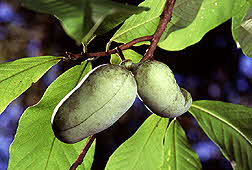Home | FOOD ARTICLES | Food Trivia | Today_in_Food_History | Food_History_Timeline | Recipes | Cooking_Tips | Food_Videos | Food_Quotes | Who’s_Who | Culinary_Schools_&_Tours | Food_Trivia_Quizzes | Food_Poems | Free_Magazines | Food_Festivals_and_Events
Food Articles, News & Features Section
FREE Magazines
and other Publications
Free Professional and Technical Research, White Papers, Case Studies, Magazines, and eBooks
PAWPAW, PAPAW
The pawpaw is the largest edible fruit native to the United States. Pawpaws are indigenous to 26 states, ranging from northern Florida to southern Ontario and as far west as eastern Nebraska. They have provided delicious and nutritious food for Native Americans, European explorers and settlers, and wild animals. Pawpaws are still being enjoyed in modern America, chiefly in rural areas. There are 27 varieties currently available from more than 50 commercial nurseries in the U.S.
The best way to enjoy pawpaws is to eat them raw freshly picked from the tree when they are perfectly ripe. But there are also numerous ways to use them in the kitchen and extend the enjoyment of their tropical flavor beyond the end of the harvest season.
The unique flavor of the fruit is a blend of tropical flavors - banana, pineapple, and mango. The flavor and custard-like texture make pawpaws a good substitute for bananas in almost any recipe. The common names, ‘poor man’s banana,’ ‘American custard apple,’ and ‘Kentucky banana’ reflect these qualities.
Pawpaw’s beautiful, maroon colored flowers appear in the spring, and the clusters of fruit ripen in the fall. Ripe pawpaw fruits are easily picked, yielding to a gentle tug. Shaking the tree will make them fall off. Ripeness can also be gauged by squeezing gently, as you would judge a peach. The flesh should be soft, and the fruit should have a strong, pleasant aroma. The skin color of ripe fruit on the tree ranges from green to yellow, and dark flecks may appear, as on bananas. The skin of picked or fallen fruit may darken to brown or black.
Fully ripe pawpaws last only a few days at room temperature, but may be kept for a week in the refrigerator. If fruit is refrigerated before it is fully ripe, it can be kept for up to three weeks, and can then be allowed to finish ripening at room temperature. Ripe pawpaw flesh, with skin and seeds removed, can be pureed and frozen for later use. Some people even freeze whole fruits.
Pawpaws are very nutritious fruits. They are high in vitamin C, magnesium, iron, copper, and manganese. They are a good source of potassium and several essential amino acids, and they also contain significant amounts of riboflavin, niacin, calcium, phosphorus, and zinc. Pawpaws contain these nutrients in amounts that are generally about the same as or greater than those found in bananas, apples, or oranges.
For extensive information about pawpaws visit the
Kentucky State University Pawpaw website: www.pawpaw.kysu.edu/
RELATED ARTICLES
Please feel free to link to any pages of FoodReference.com from your website.
For permission to use any of this content please E-mail: james@foodreference.com
All contents are copyright © 1990 - 2025 James T. Ehler and www.FoodReference.com unless otherwise noted. All rights reserved.
You may copy and use portions of this website for non-commercial, personal use only.
Any other use of these materials without prior written authorization is not very nice and violates the copyright.
Please take the time to request permission.
